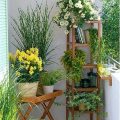Tips for Choosing Plants That Bloom at Different Times for a Year-Round Garden
Creating a garden that offers vibrant colors and blooming plants throughout the year requires thoughtful planning. Whether you’re a seasoned gardener or a beginner, the right plant selection can ensure continuous blooms, enhancing the aesthetic appeal of your outdoor or balcony space. This guide will provide key tips for choosing plants that bloom at different times, allowing for a flourishing, well-balanced garden regardless of the season.
Introduction
One of the most rewarding aspects of gardening is the ability to enjoy flowers in bloom from spring through winter. To achieve this, it’s essential to understand the growth cycles of different plants and carefully choose species that bloom at staggered times. In this article, we’ll explore strategies for selecting plants based on their bloom times, growth habits, and environmental needs. By following these tips, you’ll learn how to create a garden that thrives throughout the year, maximizing both growth and aesthetics.
Key Concepts
- Perennials vs Annuals: Perennials return year after year, often blooming in a specific season, while annuals complete their life cycle in one growing season.
- Seasonal Blooming: Choosing plants that bloom in spring, summer, fall, and winter ensures continuous color.
- Microclimate Considerations: Your garden’s exposure to sunlight, wind, and moisture affects plant bloom cycles.
- Sunlight Requirements: Some plants require full sun, while others prefer partial shade, impacting their blooming patterns.
Historical Context
Historically, garden planning has been influenced by cultural traditions and regional climates. In ancient times, gardeners in temperate zones focused primarily on seasonal crops and plants that thrived under specific weather conditions. Over centuries, techniques for creating year-round blooming gardens have evolved, especially in formal gardens like those seen in Victorian England, where staggered bloom times became an art form. Modern technology and global plant trade now allow gardeners to access a wider range of species, making it easier than ever to curate a dynamic, blooming garden year-round.
Current State Analysis
In today’s gardening world, there is an increased focus on sustainability, climate adaptability, and biodiversity. As global temperatures shift, plant selection must take into account these changing conditions. More gardeners are focusing on native species, which not only bloom reliably but also support local ecosystems. In urban environments, balcony gardening has surged in popularity, necessitating the selection of compact plants that can thrive in containers while still offering a full seasonal display.
Practical Applications
Choosing plants that bloom at different times can be achieved by following these practical tips:
- Group Plants by Season: Divide your garden into sections and plant species that bloom during different seasons in each area. For instance, place spring bloomers like tulips in one section and summer bloomers like daylilies in another.
- Mixing Perennials and Annuals: Use a combination of both to ensure there are always plants in bloom. Perennials provide structure, while annuals can fill gaps and extend the blooming season.
- Consider Height and Texture: Ensure that the blooming plants are visually balanced, with taller blooms in the back and shorter ones in front, creating a layered effect.
- Container Gardening: For balconies or small spaces, select plants like petunias or marigolds that bloom continuously in containers, ensuring they get enough water and sunlight.
Case Studies
| Case Study | Plant Selections | Bloom Times |
|---|---|---|
| English Cottage Garden | Roses, Lavender, Foxglove, Daffodils | Spring through late summer |
| Urban Balcony Garden | Geraniums, Petunias, Pansies, Chrysanthemums | Late spring through fall |
| Native Wildflower Garden | Black-Eyed Susans, Coneflowers, Goldenrod | Summer through early fall |
Stakeholder Analysis
In gardening, the key stakeholders include the homeowners, horticulturists, local ecosystems, and even pollinators like bees and butterflies. Homeowners benefit from having a visually pleasing and low-maintenance garden. Horticulturists can advise on local conditions, ensuring the selected plants are suited to the climate. Pollinators are critical as they rely on blooming plants for food; thus, having a garden with staggered bloom times helps sustain the local population year-round.
Implementation Guidelines
- Analyze your garden’s sunlight and climate conditions to understand which plants will thrive in each section.
- Choose plants with varying bloom times, such as spring bulbs, summer perennials, and fall annuals.
- Ensure adequate spacing and soil preparation for each plant species, considering their root systems and watering needs.
- Monitor and adjust as needed to support continuous blooming, pruning plants after they flower to encourage re-blooming.
Ethical Considerations
When selecting plants, it’s important to consider the ecological impact. Native plants are often the most ethical choice as they support local wildlife and require fewer resources to thrive. Avoid invasive species that may crowd out local flora, and consider water use when planting in areas prone to drought. Additionally, using organic gardening practices can ensure that your garden remains environmentally friendly.
Limitations and Future Research
While it’s possible to create a garden that blooms year-round, there are challenges depending on the climate and available space. Certain areas may not support continuous blooming due to extreme weather conditions. Future research could explore more drought-resistant, climate-adaptive plants that can thrive in changing environments. Furthermore, advancements in gardening technology, such as automated watering systems and smart sensors, could make year-round blooming more achievable for a wider audience.
Expert Commentary
Gardening experts agree that planning a garden with plants that bloom at different times requires a deep understanding of plant biology and local environmental conditions. According to seasoned horticulturists, selecting a mixture of native and adapted species offers the best results. Moreover, integrating perennials with annuals can provide both structure and variety, ensuring your garden remains vibrant throughout the year. Sustainability is key; by focusing on native species, you can support biodiversity while maintaining a stunning garden.


